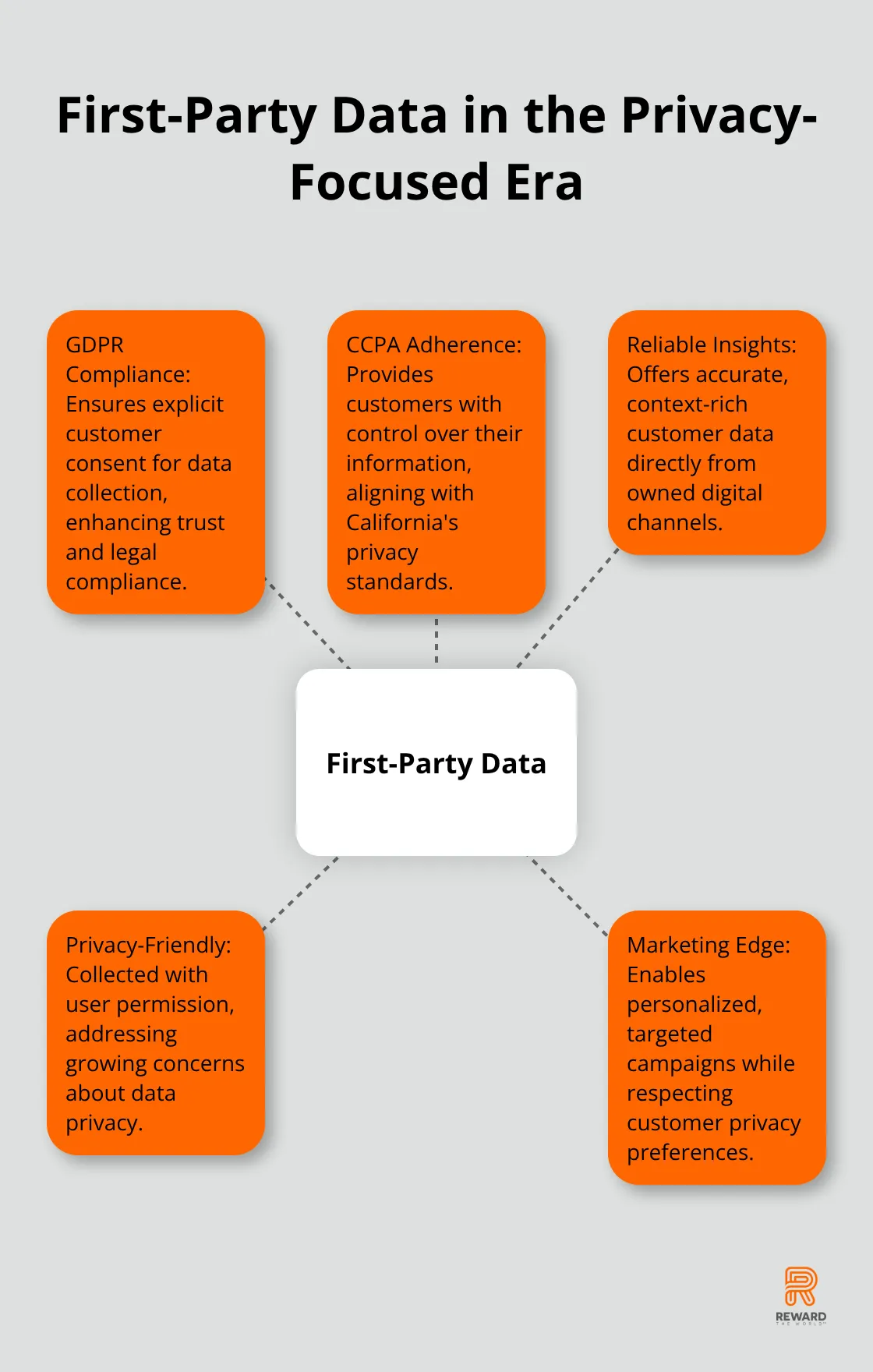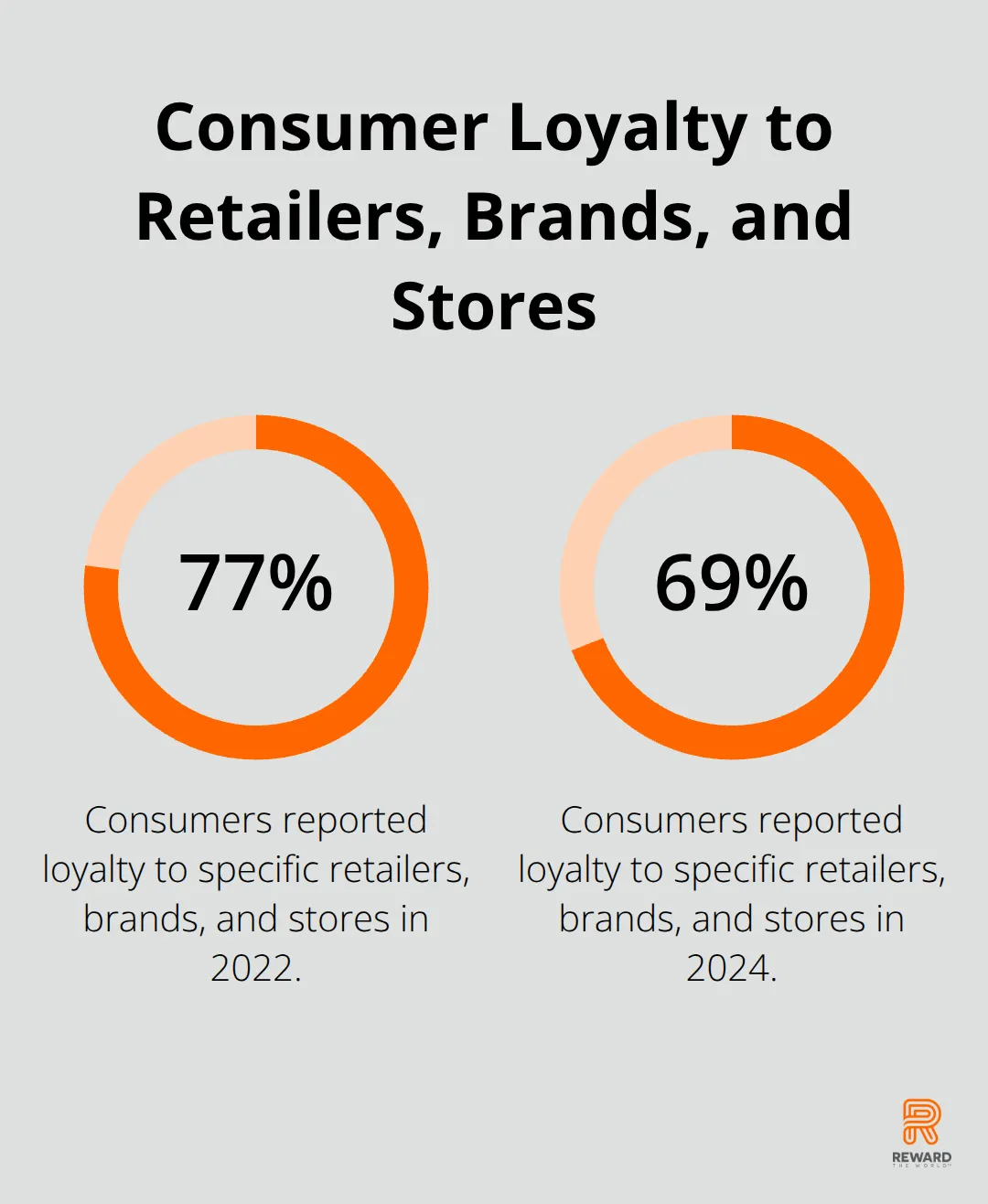
First-party data has become the gold standard in marketing. At Reward the World, we’ve seen how loyalty programs can be a powerful tool for collecting this valuable information.
In this post, we’ll explore how businesses can maximize their first-party data collection through well-designed loyalty initiatives. We’ll also discuss strategies for analyzing and activating this data to create more personalized and effective marketing campaigns.
Why First-Party Data Matters
The Gold Standard of Customer Insights
First-party data is information you collect from your audience through your owned digital channels. This makes it reliable and issue-free. It encompasses purchase history, website interactions, email engagement, and loyalty program activity (to name a few).
At Reward the World, we understand the transformative power of first-party data in shaping marketing strategies. Our platform empowers businesses to collect and leverage this data effectively, resulting in more targeted campaigns and higher ROI.
Comparing Data Sources: First vs. Second and Third-Party
While second-party data (acquired from trusted partners) and third-party data (purchased from external sources) have their place, they can’t match the quality of first-party data. These alternative sources often lack context and may suffer from inaccuracies or outdated information.
The Customer 360 Data Model loyalty subject area tracks and manages reward and recognition programs, highlighting the importance of first-party data in today’s marketing landscape.
Navigating the Privacy Landscape
The introduction of privacy regulations like GDPR and CCPA has reshaped data collection practices. These laws have amplified the value of first-party data, as it requires explicit customer consent.
Reward the World ensures all data collection practices adhere to GDPR compliance, providing businesses with confidence when using our platform. This commitment to privacy has become a key differentiator in the market.

Effective Strategies for First-Party Data Collection
- Create a robust loyalty program that incentivizes data sharing.
- Use progressive profiling to gather data over time (avoiding customer overwhelm).
- Incorporate gamification techniques to make data sharing engaging and fun.
As we move forward, let’s explore how loyalty programs serve as powerful tools for first-party data collection, striking the perfect balance between valuable insights and customer experience.
How Loyalty Programs Supercharge First-Party Data Collection
The Data Goldmine of Loyalty Programs
Loyalty programs serve as a rich source of first-party data. These programs collect valuable customer insights, including basic demographic information, purchase history, product preferences, and engagement patterns. More sophisticated programs even capture lifestyle data, brand affinities, and social media interactions.
A Salesforce study reveals that 56% of consumers are more likely to buy from a brand with a loyalty program. This high adoption rate underscores the effectiveness of these programs in data collection.

Incentivizing Participation
The success of data collection through loyalty programs hinges on creating compelling incentives. The importance of offering tangible benefits in exchange for data is clear.
Tiered reward structures prove particularly effective. As customers progress through different levels, they unlock more exclusive rewards (encouraging ongoing engagement and data sharing).
The Personalization Payoff
First-party data from loyalty programs powers personalization. This preference for tailored experiences underscores the value of data collected through loyalty initiatives.
Businesses leverage this data to create highly targeted marketing campaigns, recommend relevant products, and predict future customer behavior. This level of personalization enhances the customer experience and drives business results.
Balancing Data Collection and Customer Experience
Data collection must maintain a positive customer experience. Transparency plays a key role.
Clear communication about data usage and giving customers control over their information builds trust and aligns with privacy regulations like GDPR and CCPA.
The Future of Loyalty-Driven Data Collection
AI and machine learning will play an increasingly important role in loyalty program data analysis. These technologies uncover deeper insights and enable more sophisticated personalization strategies.
The integration of loyalty programs with other customer touchpoints will create a more holistic view of the customer journey. This comprehensive approach will allow businesses to deliver seamless, personalized experiences across all channels.
As we move forward, let’s explore how businesses can effectively analyze and activate the wealth of first-party data collected through loyalty programs to create more impactful marketing strategies.
Turning Loyalty Data into Action
Powerful Tools for Data Analysis
Customer Data Platforms (CDPs) revolutionize the analysis of loyalty program data. These platforms consolidate information from various touchpoints, creating a comprehensive customer view. In 2024, 69% of respondents reported loyalty to specific retailers, brands, and stores, a drop from 77% in 2022.

Machine learning algorithms identify patterns and predict future behavior. AI-driven personalization can boost conversion rates by up to 1.7 times in marketing campaigns.
Personalization That Drives Results
Loyalty program data enables hyper-personalized marketing. 80% of consumers are more likely to make a purchase when brands offer personalized experiences (Epsilon study).
Dynamic content personalization tailors email content, website experiences, and in-app messaging based on individual preferences and behaviors. This approach has increased engagement rates by up to 250% for some brands.
Predictive product recommendations analyze purchase history and browsing behavior to suggest products customers are most likely to buy. Amazon attributes 35% of its revenue to its recommendation engine, highlighting this strategy’s potential.
Targeted Campaigns That Convert
Segmentation creates targeted campaigns that resonate with customers. Personalized campaigns can deliver 5-8 times the ROI on marketing spend compared to generic campaigns (McKinsey study).
Behavioral triggers send automated messages based on specific customer actions (or inactions). A re-engagement email sent to customers who haven’t made a purchase in 30 days can boost conversion rates by up to 50%.
Loyalty tiers drive targeted campaigns. Exclusive perks or early access for higher-tier members encourage increased engagement and spending. Sephora’s Beauty Insider program has been a major success, with 17 million members in North America alone responsible for 80% of the company’s sales.
Continuous Optimization
A/B testing different campaign elements leads to significant improvements in performance. HubSpot reports that A/B testing can increase conversion rates by up to 49%.
The future of marketing is data-driven, and loyalty programs lead the charge. Reward the World’s platform empowers businesses to leverage these strategies effectively, transforming raw loyalty program data into powerful, personalized marketing campaigns that drive real results.
Final Thoughts
First-party data collection through loyalty programs transforms modern marketing. Businesses access valuable customer insights, create personalized experiences, and launch targeted campaigns. This approach increases customer engagement, boosts conversion rates, and improves marketing ROI.
The future of data-driven loyalty marketing will evolve with AI and machine learning. These technologies will analyze customer data, predict behavior, and enable sophisticated personalization strategies. Companies must implement or optimize loyalty programs to stay competitive in this landscape.
Reward the World offers a solution for businesses to harness first-party data through loyalty initiatives. Our platform (with global reach and instant reward delivery) empowers companies to create meaningful customer connections. Don’t miss this opportunity to transform your customer engagement and boost your bottom line.
